Along with the benefits for both employees and businesses, the increasingly remote working settings introduce specific challenges, such as retaining talent and maintaining a connected, engaged, and motivated workforce despite the spatial distances. With the excessive cost of employee turnover and the lasting great resignation, employee retention in remote work has become a top priority.
The overall cost of replacing an employee encompasses hiring expenses, training, and lost productivity, totaling between three and four times the salary of the particular position. As more than half of the workforce is open to new hiring opportunities or actively looking to change jobs, developing effective employee retention strategies is critical.
This article explores the particular challenges to employee retention in remote work arrangements and offers seven tried and tested strategies to engage dispersed staff.
The Critical Role of Employee Engagement and Retention
Improving employee retention is beneficial for all aspects of operational efficiency and workplace culture. Here are some of the key advantages:
Reduced recruitment costs: Lower expenses from less frequent need to advertise, interview, and onboard new hires
Preserved company knowledge: Retention safeguards the invaluable insights and understanding long-term employees have of the company
Productivity boost: Experienced employees work more efficiently, enhancing overall output and effectiveness
Improved employee morale: A stable workforce enhances job security and value among employees, boosting organizational morale
Attracting new talent: High retention rates signal a positive workplace, making the company more appealing to potential employees
Reduced learning curve: Fewer new hires mean less time spent acclimating to the job, ensuring steadier performance
More accurate long-term planning: Stability in the workforce enables better forecasting and strategic decisions
Customer satisfaction: Familiarity with roles and client relationships by long-term employees leads to better service and satisfaction
When discussing staff retention, we have to touch upon another highly relevant concept - employee engagement. Engaged employees are more likely to stay, driven by a strong sense of commitment and the desire to contribute meaningfully to their work environment. That’s why the journey to improved talent retention involves enhancing engagement.
Additionally, establishing a culture of belonging and diversity, equity, and inclusion (DEI) initiatives significantly impacts retention. These enhance job satisfaction, reduce conflict, and build trust, thereby contributing to the organization's overall success.
Challenges in Remote Employee Retention
Retaining remote employees presents unique challenges, including the following:
Engagement: Remote employees may feel isolated, affecting their motivation and sense of belonging to the organization. This is a major concern for 70% of remote workers.
Connectivity: Technical issues can disrupt smooth communication, while differences in time zones complicate synchronous interactions. Furthermore, the lack of adequate digital tools for collaboration can hinder the efficiency of remote employees.
Visibility: Remote employees often worry about their contributions and achievements being overlooked or undervalued due to their physical absence from the office. This "out of sight, out of mind" concern can lead to anxiety about career progression opportunities within the company.
How to Retain Remote Employees
Navigating the retention of remote employees requires innovative strategies tailored to the unique dynamics of digital workspaces. Through actionable insights, we aim to empower organizations to build a resilient, satisfied, and committed remote workforce.
Pre-Hiring: Laying the Foundation for Long-Term Retention
Retention efforts must begin before a candidate is hired. During the recruitment process, it's important to assess not just the candidate's skills but also their career aspirations, cultural fit, and how well they align with the team they'll be joining. An effective candidate evaluation takes into account the following aspects.
Career motivations and company offerings: Ensuring candidate motivations align with what the company offers to meet expectations and foster job satisfaction.
Career goals alignment: Matching a candidate’s ambitions with the company’s growth opportunities to encourage long-term commitment.
Cultural fit: Finding candidates who share the company’s values and culture to enhance harmony and retention.
Personality and team dynamics: Integrating personalities that complement team dynamics for a collaborative environment.
Work style compatibility: Identifying work styles that align with team operations for optimal performance and integration.
Communication skills: Prioritizing clear verbal and written communication skills for effective remote collaboration.
Long-term aspirations: Ensuring the company’s offerings align with the candidate’s career plans for mutual long-term goals.
Compatibility with remote work environment: Evaluating readiness for remote work, including time management, self-motivation, and productivity maintenance.
Tools like TeamEx implement AI-enabled talent screening and evaluation in the hiring process. This can help identify candidates who are not just skilled but are also a good cultural and personality fit and are likely to stay with the company long-term.
Ready to optimize your hiring journey?
TeamEx reduces hiring costs by 95%, hiring time by 90%, and ongoing talent management cost by 50%
Schedule a Call







































































Post-Hiring: Ensuring Continued Engagement and Satisfaction
1. Develop and Communicate a Unified Employee Engagement Strategy
Organizations must establish and share a comprehensive strategy for engaging remote employees. This involves continuous efforts to solicit and act on employee feedback, utilizing technology for regular check-ins, and ensuring every voice is heard.
Such an approach not only makes remote employees feel valued but also nurtures a culture of belonging and continuous improvement. A well-communicated engagement strategy reinforces the importance of each employee's contributions, fostering a unified commitment to growth and adaptability.
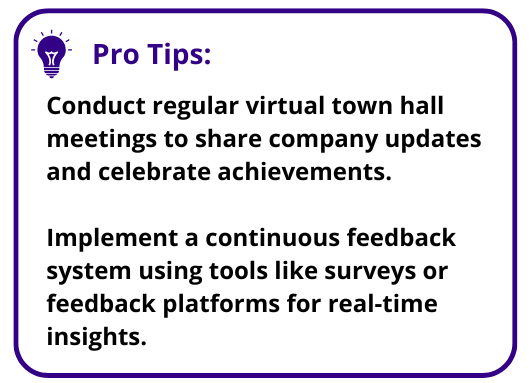
2. Create a Seamless Remote Onboarding Experience
A well-structured onboarding process is crucial for integrating remote employees into the company culture from the very beginning. This process should clarify role expectations and foster a sense of belonging, ensuring new hires understand their contributions towards the company's goals.
Incorporating digital tools and platforms can streamline this process, making it more efficient and engaging for remote workers.
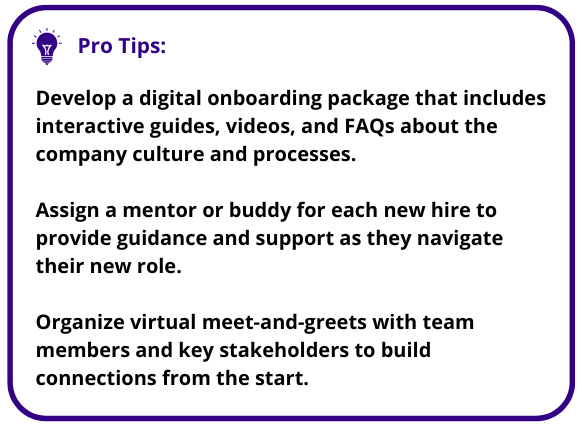
3. Prioritize Flexibility and Work-Life Balance
Offering flexible work arrangements, including hybrid models, is essential to accommodate the diverse needs and preferences of remote employees. This flexibility supports a healthy work-life balance, which is a key factor in job satisfaction and retention.
Companies should encourage employees to customize their work schedules, promoting a culture of trust and autonomy.
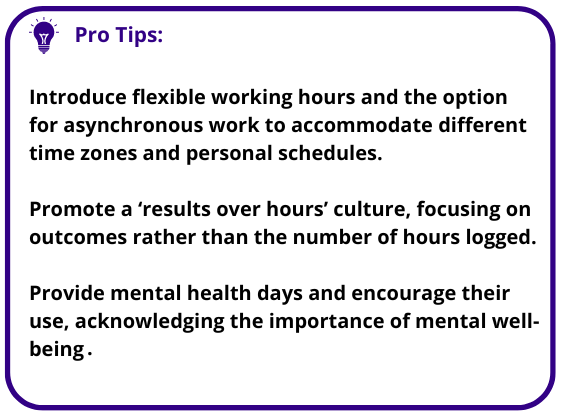
4. Promote Professional Growth and Development Opportunities
Continuous learning and development opportunities are vital for career progression. By offering mentorship programs and access to training resources, companies can support the professional growth of their remote employees. Encouraging participation in projects that align with their career aspirations can also help employees see a clear path for advancement within the organization.
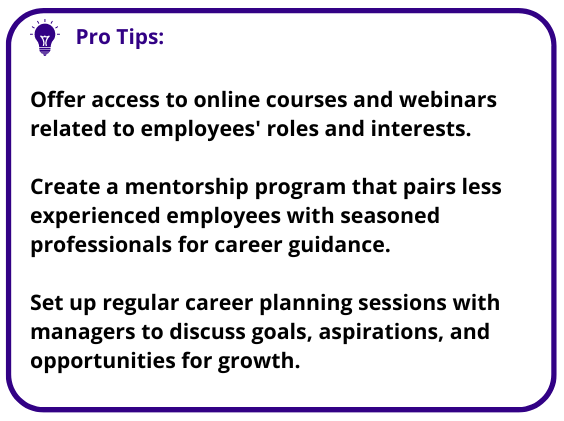
5. Provide Relevant and Creative Compensation and Benefits
Competitive compensation packages for remote employees should extend beyond salary to include health benefits, well-being programs, and non-monetary perks. Health benefits, including mental health support, offer peace of mind, while well-being programs promote work-life balance.
Non-monetary perks like professional development opportunities and recognition programs foster a sense of purpose and engagement. Such comprehensive packages cater to employees' diverse needs, fostering a supportive work environment that encourages long-term commitment.
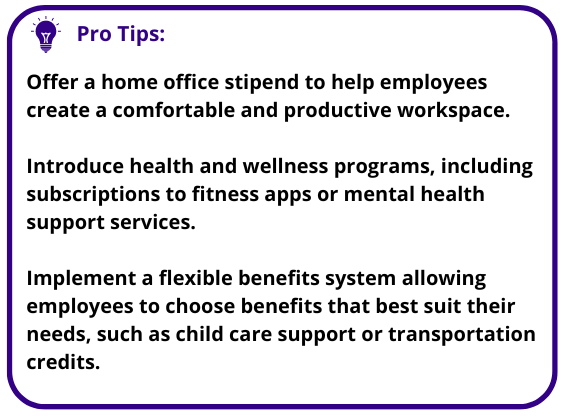
6. Foster a Robust Remote Work Culture
A strong remote work culture, which champions collaboration, innovation, and inclusivity, is crucial for successful organizations with dispersed workforces. Collaboration ensures seamless teamwork despite physical distance, while innovation is fostered in an environment that values diverse thoughts and encourages risk-taking.
Inclusivity, ensuring all employees feel valued and included, enhances employee satisfaction and retention. Such a culture unites a dispersed workforce, drives innovation, and creates an equitable environment, positioning organizations to navigate remote work challenges, achieve strategic objectives, and promote long-term growth.
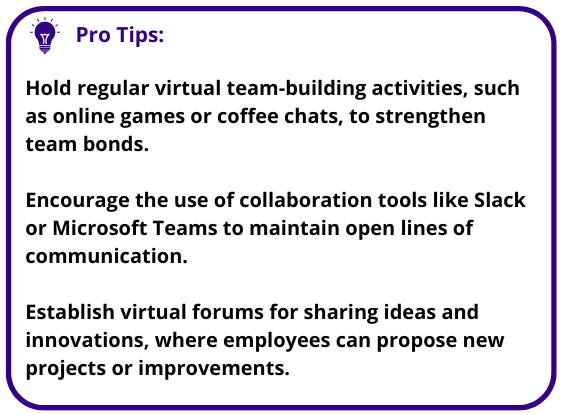
7. Implement Effective Management Practices
Effective management is crucial for remote employee retention, requiring empathetic leadership, clear communication, and support for employee autonomy. Empathetic leaders understand their team's challenges and foster trust. Clear communication ensures employees are well-informed and aligned with the organization's vision. Supporting employee autonomy empowers them, fostering a sense of ownership and responsibility, which boosts confidence and encourages innovation.
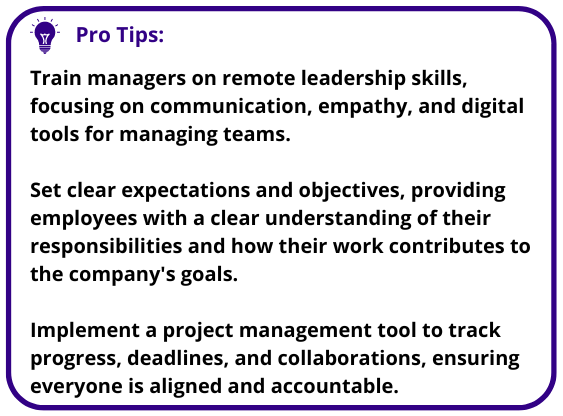
Implementing the right technology can streamline talent acquisition, onboarding, and managing remote teams. Remote recruitment platforms like TeamEx simplify the remote hiring process from candidate screening and interviewing to payroll management. Talent pool expansion, automating hiring processes, effective onboarding, and enhanced remote team management are among the benefits brought to businesses.
Remote Employee Retention Case Studies
Here are some examples of companies that stand out with their remote employee retention.
Slack's Digital-First Approach
Context: Slack, the communication platform, adopted a "Digital First" philosophy, acknowledging that remote work is not just a temporary measure but a permanent shift in how work is done.
Strategy: Slack redesigned its operations around digital tools and asynchronous work, ensuring that employees have flexibility in their schedules and work locations. They also invested in virtual team-building activities and regular check-ins to maintain a strong company culture.
Outcome: Slack has reported maintaining high retention rates and employee satisfaction, with their strategies serving as a model for other companies navigating the transition to remote work.
Dropbox's Virtual First Toolkit
Context: Dropbox announced a "Virtual First" policy, redefining the traditional office as a space for collaboration rather than day-to-day work.
Strategy: To support this transition, Dropbox developed a Virtual First Toolkit, offering resources on setting up home offices, managing remote teams, and fostering online collaboration. They also introduced "non-linear workdays," allowing employees to design their work schedules around their most productive hours.
Outcome: The Virtual First policy and toolkit have helped Dropbox maintain employee engagement and productivity, with positive feedback from employees on the flexibility and autonomy they now enjoy.
Zillow's Transition to Remote Work
Context: Real estate tech company Zillow was among the first to announce a permanent shift to remote work in response to the pandemic, recognizing the changing landscape of work-life balance.
Strategy: Zillow implemented a flexible work model, allowing employees to work from anywhere, and focused on redesigning their digital collaboration tools to enhance productivity and engagement among remote teams.
Outcome: The company reported increased employee satisfaction and engagement levels, with a significant reduction in turnover rates. Zillow's leadership credited their proactive communication and investment in remote infrastructure for these positive results.
Salesforce's Success from Anywhere Model
Context: Salesforce introduced a "Success from Anywhere" model in response to employee feedback for greater flexibility post-pandemic.
Strategy: The model allows employees to choose whether to work from home, in the office or a combination of both. Salesforce has also invested in technology to support remote collaboration and reimagined their office spaces as community hubs for team gatherings and client meetings.
Outcome: Salesforce has reported that this flexible approach has been key to retaining talent and attracting new employees looking for a more adaptable work environment.
Leverage Technology for Achieving Employee Retention in Remote Work
To effectively retain remote employees, adopting strategies that enhance engagement, clear communication, work-life balance, and professional growth is essential. Technology serves as a powerful tool to track engagement, offering real-time insights into employee sentiment, engagement levels, and potential areas for improvement. Thus, utilizing technology helps optimize retention initiatives and highlight opportunities for improvement.
Platforms like TeamEx simplify the remote hiring journey, from screening to onboarding and comprehensive team management, supporting a strong remote work culture.
Discover how TeamEx can revolutionize your approach to remote hiring and retention, empowering your team to thrive in a remote work environment.








































































Frequently Asked Questions About Employee Retention
What does retention mean in staffing?
Retention in staffing refers to the ability of a company to keep its employees over a period of time. This is often considered a measure of the company's work environment and benefits. It encompasses the strategies, practices, and overall environment an employer uses to maintain a stable workforce.
What are the 4 pillars of employee retention?
Effective employee retention practices focus on ensuring workers are engaged and satisfied, and find meaningful value in their work, contributing to their decision to stay with the company over time. This involves understanding and addressing the diverse needs and expectations of the workforce, including:
Career development opportunities
A positive work culture
Competitive compensation and fair rewarding
A positive work-life balance
How to retain remote employees?
To retain remote employees, focus on creating a supportive and engaging work environment that includes clear communication, flexible work arrangements, opportunities for professional growth, competitive compensation and benefits, a strong remote work culture, and effective management practices.


